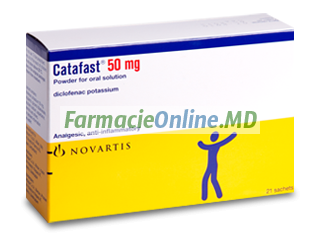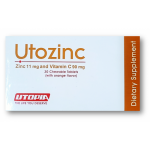
Catafast® 50 mg
granules for oral solution
Diclofenac potassium
Catafast soma granules for oral solution :
every sachet contains diclolenac potassium 50 mg.
Excipients :
saccharose, aspartame, potassium bicarbonate, anise eromatic powder, mint aromatic powder, menthol, sodic saccharine
Pharmaceytlcal form and content :
9 sachets 01 granulated product, kM’ oral solution, each containing 50mg.
pharmacotherapeutic category :
Anti-inflammatory, anti-rheumatic non-steroidal substance.
Indications I potential uses :
Short-term treatmenl (maxium 2 weeks) of the following acute oonditionI:
-postoperative inflamatione and pain e.g following dental or orthopeadic surgery
– painful post traumatic pain inflammatory states e.g due to sprains
-painful and/or inflammatory gynaacological conditions ,e.g. primary dysmenorrhoaa or adnxitis
– Migraine attacks
-as an adjunct in severe painful inflammatory infectione of the ear nose or throat e.g
– painful syndromes of the vertebral column
– non articular rheumatism
-In keeping with standard therapeutic principles the undertying diseasae should be treated with specific therapy as appropriate.
-Fever alone is not an indication
Contraindications :
Peptic andIOf gastric ulcers, hypersensitivity 10 the components and/or 0th-
er substances chemicaJty stnctfy ccoeetee to them and in particular hyper-
sensitivity to acetyl salicylic acid and in general to the non-steroidal an-
algesic antipyretic anti-inflammatory drugs, progressive liver diseases and
grave renal dyslunction (insufficiency). ceiaresr is contraindicated in pa-
tients in whom attacks of asthma, urticaria or acute rhinitis are pre-
cnpitated Of worsened by acety1salicylic acid Of other drugs with pros-
taglandin-synthetase inhibiting activitieS. Due 10 the preseoce of
aspartame. catetest granulated soluble in mouth is contraindicated in pa-
tients with phenylketonuria Catalast is also contraindicated in children (less than 14 years of age). It is generally contraindicated in pregnancy, particularly during the last (third) trimester (see special warnings) and during lactation
precautions on Use :
The physician must take great care in case 01 treatment 01 patients with
gastrointestinat symptoms, a history of peptic/gastric ulcer, ulcerative 001-
itls, Crohn’s disease Of grave impaired hepatic lunction. In al such cases,
treatment shall be kept lRier close medical supervision. In general, gas-
ttointestinal bleeding Of ulceratlOf\lperforalion have even more serious
consequences in the elderty. They can occur at any time during treat-
ment without warning symptoms Of previous history. In the rare events
of gastrointeslinal bleeding or ulceration, the drug should be withdrawn.
Owing 10 the importance 01 prostaglandins in maintaining renal blood f1ow,
particular caution is called in patients with impaired renal Of cardiac blood
flow, the elderty, patients being trealed wrth diuretics and those with ex-
tracellular volume depletion. In such cases, monitomg of renal function
during treatment wrth catetasr is recommended. Withdrawal 01 the drug
is usualfy followed by a return to the pre-treatment state.
In any case, particular caution is indicated in old patients or those with a
low bodyweight: in particular it is recommended to administer the lowest
effective dosage.
As with other NSAIDs. vaJues of one Of more liver enzymes may incfease. As
a precaUbonary measure, it is recommended to monitor the hepatic Iooction.
The ttealJ”nent wrth this drug shoukf be disconllnued if tests should show
that liver funcuoo dISturbance persists Of worsens or if other grave man-
ifestations or symptoms consistent with liver disease develop Of if other
grave manifestations occur. Particular care IS called in pannets with he·
patiC porphyria, since diclolenac may trigger an attack.
Treatment with Catalast in the Indications listed above is recom’menoed
only IOf limited periods. If, however, there should be a necessity for ustlg
IhisrnedicWleIor8Iongperiod,ilisadvisabletoperformblood As with other NSAtDs, the use of caiarest can cause ailefglC reactions even in the absence of previous exposure Like other NSA1Ds, the use of cetetesr may mask the symptoms 01 in- fective diseases, mus clelaying sound diagnosis alld sound treatment.
Interactions :
When gJV&n concomiIanI!y wrth preparations containing digoxin Of lithium, didoIen8c may incfease 1tIeir plasma concentrations Many NSAIDs are capable of inhibiting the activity 01 diuretics. C0n- comitant treatment with potassium-sparing diuretics may be aseoctatec with increased serum potassium levels, thus these should necessarily be checked regularty. Although no data in clinical investigations suggested that diclofenac coukf have an anticoagulant effect, there haVe been isolated reports of an in risk of haemor”rhage in patieots receiving catalast and an anti- coagUlant therapy concomitantly. Close monilomg of such patients Is therefore recommended. Like other NSAIDs, OiClolenac at high dosage (2OOmg) may temporarily Inhibit platelet aggregation. Clinical studies have shown that diclOfenac can be given together wilh oral antidiabetic agents without influencing their clinical effect. However,
there have been ~ted reports of both hypoglycaemic and hyper-
glycaemic effects during treatmenl with didoIenac, necessitating c:hanges
in the antidiabelic drug dosage. Special caution is required when NSAIDs are administered less than 24 hours before treatment with methotrexate, as blood concentrations of me- thotrexate can rise, increasing its toxicity.The effects of NSAIOs on renal prostaglandins may Increase the neph-
rotoxicity 01 cyclosporin.
Special Warnings :
Coocomitanl use of diclolenac with other non-steroidal antHnftammalory agents can increase incidence of side effects as in the case 01 use 01 Catalast con- comitantiywith cortisones whictl can accentuate gastrointestinalside effects.
Use in pregnancy and lactation :
During pregnancy, this drug may be administered only after careful scar-
uation of risklbenefit analysis and in any case, with the lowest effective
dosage.This drug may not be used during the third trimester of pregnancy
owing to the possibility 01 delaying delivery and slackening labour. It is
necessary to underline the risk 01 haemorrhage that can arise from ad-
ministration 01 NSAIDs during the terminal phase 01 pregnancy. After oral
doses 01 SOmg every 8 hours, diclolenac excreted in breast milk is so
small that adverse effects in the neonate are unlikely.
Effects on the capacity to gYide motorcars or operate machines :
those patients who have experienced vertigo. fits of dizziness or other CNS disturbances shall refrain from guiding cars or operating machines requiring attention.
Dosage Method and time of Administration :
-In post-traumatic pains, postoperative cases and in the treatment of se-
vere acute csteoarncurar rheumatic pain. the attack dose in adults is in
the range of 10().150mg per day divided into 2·3 administrations. In mild-
er cases as well as for adolescents over 14 years of age, a dose ranging
between 50 and 100 mg daily will generally suffice. In primary dysmenorrhoea, the daily dosage, which should be individually adjusted, is generally between 50 to 150 mg and, if necessary, it may be raised over the course of other menstrual cycles until it reaches a maxi- mum of 200 mg daily. \I is advisable to start treatment upon onset of the early symptoms and continue it for a few days depending on symp- tomatology.
Migraine: An initial dose of 50 mg is recommended at the first sign of an
impending attack. In cases where pain relief is inadequate approx. 2
hours after ingestion of the first dose a further dose of 50 mg may be tak-
en. I1 necessary, further 50 mg doses may be taken at intervals of 4-6
hours. although a total dose 01200 mg must not be exceeded within a 24-
hours period Oon’t exceed the doses recommended. The content of the sachet is to be melted in a hall glass of natural water prelerably before meals. Possible opalescence 01 the solution does not indicate impairment of the efficacy of the preparation.
overdosage :
The procedure of management to be adopted in case 01 acute poisoning
with NSAIDs is essentially a procedure 01 supportive or symptomatic meas-
ures. No typical clinical picture associated with overdosage of diclolenac
exists. In case of overdosage, it is necessary to prevent absorption as
soon as possible by means 01 gastric lavage and activated charcoal.
Adequate symptomatic or supportive measures to combat hypotension,
renal damage, convulsions. gastrointestinal lesions and respiratory de-
pression must be employed and taken.
Undesired effects and adverse reactions’ :
ctsrurtercee like nausea, vomiting, diarrhoea. abdominal cramps. dyspepsia, flatuler’ICe, anorexia (lOSS of appetite) .BamJx; gastrointesUna! bleeding, haematemesis, meieoe, peptic ulceration with or without bleeding or perforation, bloody diarrhoea In isolatftd cases· lower gastrointestinal disorders (such as haemorrhagic inllammation and ulcerative colitis) pancreatitis (the cause/effect re- lationship is not known well). aphthous stomatitis, glossitis, oesophageal lesions, diaphragm disease. Special attention must be paid to possible appearance 01 superliciallesions or ulcers in the stomach. Sometimes these lesions happen without previous warning symptoms other than those noted above, namely loss of occult blood or emission 01 black faeces.
Centra! and perlphera! nervous system :
headache, vertigo drowsiness
In isolated cases : sensory disturbances, Paraesthesias, memory dis turbances. disorientation, disturbances of vision, impaired hearing. tinnit- us, insomnia, irritability. convulsions. depression. anxiety, nightmares, tremor, psychotic reactions, taste alterations.
Storage conditions’ :
Store below 3O”C and protect from moisture
AttentIon:
do not use this medicine beyond the expiry date indicated on the package. Such dates are applicable only if both packing and storing are sound.
packs :
pack of 9 sachets
Produced by :
NOVART1S PHARMA S.A.E. – Cairo

